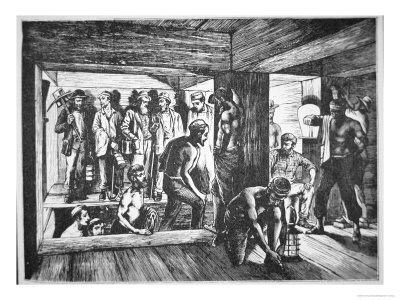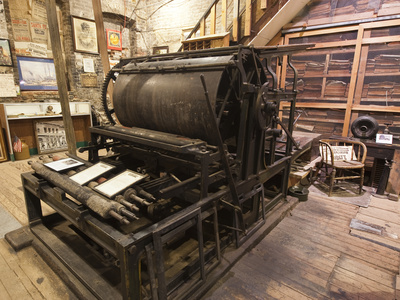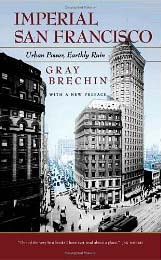VIPS in the Port of San Francisco

Henry Comstock
1830-1898
Gold was found at the head of Six-Mile Canyon in Nevada in 1859 by two miners named Pat McLaughlin and Peter O'Reilly. A fellow miner, Henry Comstock, stumbled upon their find and claimed it was on his property. The gullible McLaughlin and O'Reilly believed him and assured Comstock a place in history when the giant lode was named. Following the gold up the canyon an outcropping of gold in quartz was found.
 |
| Silver Miners in the Comstock Lode Virginia City, Nevada |
The biggest problem in this grubstake paradise was the sticky blue-gray mud that clung to picks and shovels. When the mud was assayed, it proved to be silver ore worth over $2,000 a ton - in 1859 dollars!
Gold mixed with high quality silver ore was recovered in quantities large enough to catch the eye of President Abe Lincoln. He needed the gold and silver to keep the Union solvent during the Civil War. On October 31, 1864 Lincoln made Nevada a state although it did not contain enough people to constitutionally authorize statehood.
The rush to the Comstock in 1859 virtually shut down the mines of California. A new era dawned, scientifically, economically, and socially. By the late 1850s, thousands of gold seekers were doubling back from California, through the Western territories. Many were professional prospectors by now, roving from one small strike to the next. Others belonged to a new wave of novices, fleeing a severe financial depression back East.
All were scratching the mountain dirt for "color" when some electrifying news came drifting over from the eastern slopes of the Sierra Nevada - some "blasted blue stuff" that had been found was actually a fabulous silver strike, the legendary Comstock Lode, probably the greatest single mineral strike in history.
>Mining on the Comstock

During the next year, 17,000 swarmed into the Washoe region of what is now the state of Nevada.
Located in the northwestern corner of Nevada, bordering Oregon to the north and California to the west, Washoe County was a crossroads for miners seeking riches in the California Gold Rush and later in the neighboring Comstock Lode. Occupied by the Wassau (or Washo) and Paiute Indians, Washoe County was explored by John Bidwell in 1841 and John C. Fremont in 1844. Settlers began to arrive in the area claimed by Utah Territory as part of Tooele County in 1852, and it became part of Carson County in the Nevada Territory in 1854. Washoe County became one of the original nine counties in the Nevada Territory in 1861 and expanded to its current size with the addition of Lake or Roop County land in 1864.
"Frame shanties pitched together as if by accident - tents of canvas, of blankets of brush, of potato-sacks, and old shirts, with empty whisky barrels for chimneys - coyote holes in the mountain-side forcibly seized and held by men - pits and shafts with smoke issuing from every crevice - piles of goods and rubbish in the hollows, on the rocks, in the mud, in the snow everywhere, scattered broadcast in pell-mell confusion."
Seemingly overnight, the mud metamorphosed into pop-up villages -- Gold Hill, Silver City, Virginia City.
"Houses are built anywhere and everywhere, and the streets are then made to reach them... The people were camped all around in wagons, tents and temporary brush houses or wickiups. The principal business houses were saloons, gambling houses, and dance halls, two or three so-called stores with very small stocks of general merchandise and little provisions."
Mark Twain, after an unsuccessful stint as a prospector, found himself working for Virginia City's largest newspaper. Part of the job involved shameless promotion of fair-to-middling claims in exchange for free shares --
"If the rock was moderately promising, we followed the custom of the country, used strong adjectives, and frothed at the mouth as if a very marvel in silver discoveries had transpired. If the mine was a 'developed' one we would squander half a column of adulation on a shaft, or a new wire rope, or a dressed-pine windlass, or a fascinating force pump."

Early arrivals included lawyers, freighters, and merchants, as well as the men and women who earned a living providing for the miners.
"My husband is to do the blacksmithing for the company, and as was arranged, I am to cook for the men. My heart sinks within me when I see 18 or 20, and no conveniences at all. They are so filthy they require a great deal of cleaning wherever they go, and this wears out a woman very fast."
As one incredibly rich strike followed another, a financial community materialized. An outdoor stock market blossomed along the muddy streets of Nevada's Virginia City. Shares in mines zoomed from a dollar and a half to above $1,500 in not much more than a year's time.
With the gold and silver came the building of the Virginia & Truckee Railroad, which ran from Reno to Carson City to Virginia City and later to Minden. The investments made in mining on the Comstock in the 1860's, 1870's and 1880's fueled the building of San Francisco. Wm. Ralston and Crocker, founders of the Bank of California made their money in Virginia City. Names like Leland Stanford, George Hearst, John Mackay, Wm. Flood and many others made their fortunes in Comstock mining.
In 1869, a railroad was built to link Virginia City with Carson City on the river. It took 30 days to lay out the railroad, but nine months to build it with a crew of 1200 laborers, mostly Chinese. The Nevada line was soon connected to the nation's first transcontinental railway, completed the same year. The railroad brought not only industrial supplies to Virginia City but the Eastern effects of a finer life - fancy furniture, stone for an opera house (performers included Artemus Ward and Edwin Booth), and carved woodwork for a six-story hotel.

"The flush times were in magnificent flower!" wrote Mark Twain. "The 'city' of Virginia claimed a population 18,000, and all day long half of this little army swarmed the streets like bees, and the other half swarmed among the drifts and tunnels of the Comstock, hundreds of feet down in the earth directly under those same streets. Often we felt our chairs jar, and heard the faint boom of a blast down in the bowels of the earth under the office."
Probing the Comstock continued from 1860 to the late 1880s; throughout the period, technological advances fed other changes as well. Hauling industrial-strength machinery, supplies and ore was soon beyond the capabilities of mule and wagon freight operations.













 Copyright ~ 1998-2018.
Copyright ~ 1998-2018. 